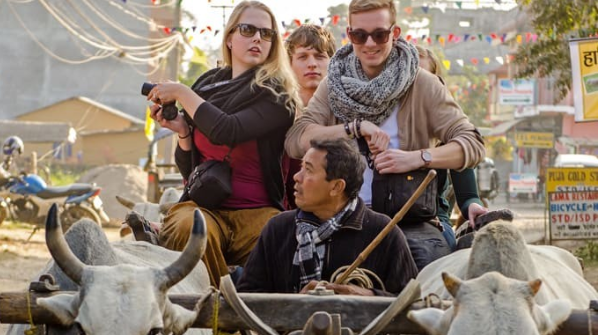Nestled in the heart of the Himalayas, Nepal is a land of incredible diversity — not just in landscapes, but in cultures, traditions, and spirituality. A Nepal Cultural Tour offers travelers a deeper connection with this enchanting country, beyond the trekking trails and mountain vistas. From ancient temples and royal palaces to colorful festivals and warm-hearted locals, this tour is an unforgettable journey through Nepal’s living heritage.
Introduction: The Soul of Nepal
Nepal is often known as the home of Mount Everest, but its true charm lies in its people and cultural richness. With over 120 ethnic groups and 100 spoken languages, Nepal is a mosaic of traditions, religions, and lifestyles. The Nepal Cultural Tour allows visitors to experience this unique blend — where Hinduism and Buddhism coexist harmoniously, and centuries-old customs still shape everyday life.
This tour is perfect for travelers who want to understand Nepal beyond its mountains — to feel the rhythm of local life, witness traditional art, and explore cities where every temple and courtyard tells a story.
Highlights of the Nepal Cultural Tour
- Explore UNESCO World Heritage Sites in Kathmandu Valley
- Visit ancient royal cities – Kathmandu, Patan, and Bhaktapur
- Experience spiritual landmarks like Pashupatinath Temple and Boudhanath Stupa
- Discover rural traditions in Bandipur and Gorkha
- Visit Lumbini, the birthplace of Lord Buddha
- Enjoy panoramic mountain views from Pokhara
- Participate in local festivals and witness traditional crafts
Kathmandu – The Cultural Heart of Nepal
The Nepal Cultural Tour often begins in Kathmandu, the bustling capital city and cultural epicenter of the country. Despite its modern chaos, Kathmandu remains deeply rooted in tradition. The city’s narrow lanes are filled with hidden courtyards, shrines, and ancient temples where life continues as it has for centuries.
Major Attractions in Kathmandu:
- Kathmandu Durbar Square – Once the royal palace complex, this area is filled with courtyards, pagoda-style temples, and intricate wood carvings.
- Swayambhunath (Monkey Temple) – A sacred Buddhist stupa perched on a hilltop, offering sweeping views of the valley.
- Pashupatinath Temple – Nepal’s holiest Hindu temple, dedicated to Lord Shiva, where pilgrims and sadhus gather for rituals along the Bagmati River.
- Boudhanath Stupa – One of the largest stupas in the world, surrounded by prayer flags and monasteries, symbolizing Nepal’s deep Buddhist heritage.
Each of these sites reflects Nepal’s unique fusion of Hindu and Buddhist traditions — often existing side by side in harmony.
Patan – The City of Fine Arts
Just a short drive from Kathmandu lies Patan, also known as Lalitpur, meaning “City of Beauty.” This ancient city is renowned for its exquisite craftsmanship and centuries-old architecture. The Patan Durbar Square is home to ornate temples, royal courtyards, and the famous Krishna Mandir, built entirely from stone.
Patan’s narrow alleys are alive with artisans — metalworkers, woodcarvers, and sculptors who continue traditional crafts passed down through generations. Visiting Patan offers a glimpse into the artistic soul of Nepal.
Bhaktapur – The Living Museum
A UNESCO World Heritage Site, Bhaktapur is often described as a “living museum.” Time seems to stand still here, with red-brick streets, ancient temples, and artisans weaving pottery and handmade crafts.
Highlights of Bhaktapur include:
- Nyatapola Temple – A five-story pagoda and one of Nepal’s tallest temples.
- 55-Window Palace – A masterpiece of woodwork from the Malla dynasty.
- Pottery Square – Where locals shape clay into pots using age-old techniques.
Bhaktapur also hosts vibrant festivals like Bisket Jatra, offering an authentic experience of Nepalese culture and community life.
Lumbini – Birthplace of Lord Buddha
No Nepal Cultural Tour is complete without visiting Lumbini, the birthplace of Siddhartha Gautama, who became the Buddha. This sacred site in southern Nepal attracts pilgrims and peace-seekers from around the world.
The Maya Devi Temple marks the exact spot of Buddha’s birth, surrounded by monastic zones built by countries like Thailand, Japan, and Germany — each showcasing distinct architectural styles. The tranquil atmosphere of Lumbini embodies Nepal’s deep spiritual heritage and message of peace.
Pokhara – Culture Amidst Natural Splendor
While Pokhara is best known for its stunning mountain views and lakes, it also offers rich cultural experiences. Visitors can explore traditional villages like Tibetan Refugee Camp or Old Pokhara, where cultural traditions remain intact.
Pokhara is also the gateway to the Annapurna region, making it an ideal blend of nature, adventure, and culture. Don’t miss the International Mountain Museum, which celebrates the history and culture of Himalayan communities.
Bandipur and Gorkha – Glimpses of Rural Heritage
To truly experience Nepalese culture, travelers should venture beyond the cities. The hilltop town of Bandipur preserves Newari culture with traditional houses, cobblestone streets, and panoramic Himalayan views.
Nearby, Gorkha holds immense historical significance as the ancestral home of King Prithvi Narayan Shah, who unified Nepal. The Gorkha Palace and Gorkha Museum offer insights into the nation’s formation and royal legacy.
Festivals and Traditions
The Nepal Cultural Tour becomes even more magical when it coincides with Nepal’s colorful festivals. Major celebrations include:
- Dashain (September–October): The biggest Hindu festival, symbolizing victory of good over evil.
- Tihar (October–November): Festival of Lights, celebrating animals, siblings, and prosperity.
- Holi (March): The festival of colors, filled with joy and music.
- Buddha Jayanti (May): Commemorates the birth of Lord Buddha with prayers and processions.
Each festival reflects the deep spirituality and joyful essence of Nepalese life.
Art, Architecture, and Cuisine
The architecture of Nepal is a visual delight — pagoda temples, carved windows, and stupas adorned with prayer flags. Cities like Kathmandu, Patan, and Bhaktapur showcase centuries of Newari craftsmanship in wood, stone, and metal.
Food is another integral part of the cultural experience. From dal bhat (lentil soup with rice) to momo (Nepali dumplings) and Newari feasts, every dish tells a story of tradition and community.
Suggested 7–10 Day Cultural Tour Itinerary
Day 1: Arrival in Kathmandu – evening heritage walk
Day 2: Explore Kathmandu Valley (Pashupatinath, Boudhanath, Durbar Square)
Day 3: Visit Patan and Bhaktapur – overnight in Bhaktapur
Day 4: Drive to Bandipur – explore the traditional village
Day 5: Drive to Pokhara – lakeside stroll and cultural show
Day 6: Sightseeing in Pokhara (Mountain Museum, Tibetan camp)
Day 7: Drive or fly to Lumbini – explore the monastic zone
Day 8: Return to Kathmandu
Day 9: Optional day for shopping or local exploration
Day 10: Departure
Best Time for a Nepal Cultural Tour
The best times for cultural exploration are spring (March–May) and autumn (September–November). The weather is pleasant, visibility is clear, and many festivals occur during these months.
Winter (December–February) is also suitable, especially for those focusing on lowland heritage sites.
Conclusion: The Heartbeat of the Himalayas
The Nepal Cultural Tour is more than sightseeing — it’s an immersion into the rhythm of a country that bridges ancient wisdom and modern aspirations. From the spiritual aura of Lumbini to the artistry of Patan and the timeless streets of Bhaktapur, every moment unveils Nepal’s enduring soul.
Whether you’re a history lover, spiritual seeker, or curious traveler, Nepal welcomes you with open arms and a warm smile. The journey through its culture is not just about exploring monuments — it’s about discovering humanity in its purest form.

